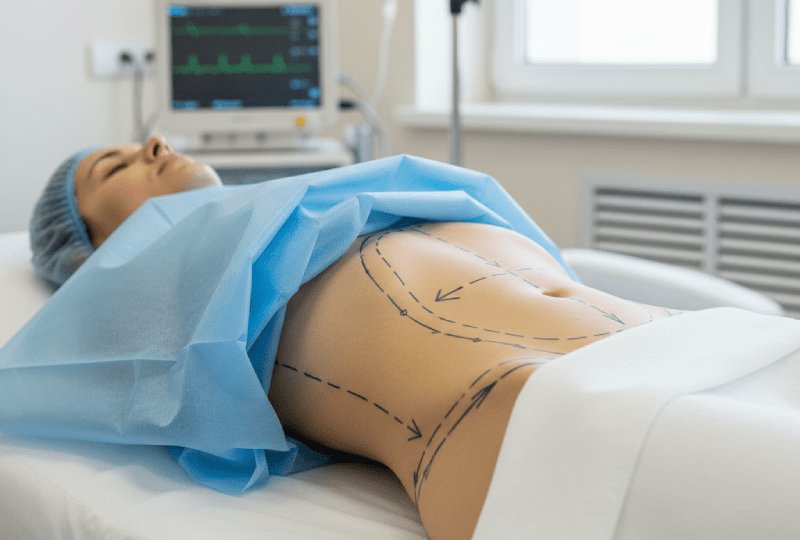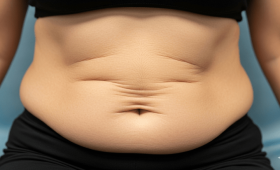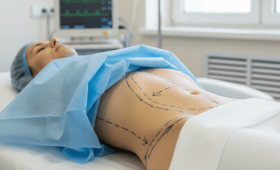Tummy tuck surgery, medically known as abdominoplasty, is a surgical procedure aimed at removing excess skin, fat tissue, and muscle laxity in the abdominal area to achieve a flatter and firmer abdominal appearance. It is typically used to correct sagging caused by factors such as significant weight loss, pregnancy, or aging, which can result in separation of the abdominal muscles (diastasis recti) and a loss of skin elasticity. In addition to aesthetic concerns, the surgery can also help resolve functional issues like hygiene problems or skin irritation caused by excess skin. The operation improves the overall contours of the abdomen, shaping the individual’s body contour and thereby boosting the patient’s self-confidence. However, like any surgical procedure, this operation requires a careful evaluation and preparation process. Plastic surgery specialists in Turkey offer services in this field that meet international standards.
Why is Tummy Tuck Performed?
Tummy tuck surgery is performed to address the discomfort people experience due to physical changes in their abdominal area. The most common reasons include:
- Post-Pregnancy Changes: During pregnancy, the abdominal muscles stretch, and the connective tissue known as the linea alba weakens. After childbirth, these muscles may not regain their former tightness, leading to laxity in the abdominal wall. Abdominoplasty corrects this condition by tightening the abdominal muscles and strengthening the abdominal wall.
- Significant Weight Loss: As a result of rapid and significant weight loss (especially after bariatric surgery), while the body’s lines slim down, a layer of loose and sagging skin may remain in the abdominal area. This excess skin is not only aesthetically unpleasing but can also cause hygiene problems. The surgery allows for the removal of this excess skin and a smoother appearance of the abdomen.
- Aging: With the aging process, the skin loses its elasticity, and sagging can occur in the abdominal area due to the effects of gravity.
- Genetic Factors: Some individuals may have a more lax abdominal wall due to genetic predisposition. Tummy tuck is also an effective method to correct such structural issues.
Who is a Good Candidate for Tummy Tuck Surgery?
Suitable candidates for tummy tuck surgery are generally those who meet the following criteria:
- In Good General Health: Individuals who do not have chronic illnesses or whose existing health problems are under control are considered suitable for surgery.
- Close to Their Ideal Weight: This surgery is not a weight loss method. The best results are achieved in patients who are close to their ideal weight and can maintain it. Significant weight changes after surgery can negatively affect the results of the operation.
- Non-Smokers: Smoking negatively affects the healing process and increases the risk of complications. Therefore, quitting smoking before and after the surgery is mandatory.
- Have Realistic Expectations: It is important for patients to have realistic expectations about what the surgery can achieve. Surgeons in Turkey help clarify these expectations during the consultation process.
- Have Sagging and Laxity in the Abdominal Area: Individuals who cannot get rid of excess skin and muscle laxity in the abdominal area despite diet and exercise can benefit from this operation.
Who Cannot Have This Surgery?
Although tummy tuck surgery is a common operation, it is not recommended or performed in some cases. These situations include:
- Obesity: Since the surgery is not a weight-loss operation, individuals diagnosed with obesity should first lose weight.
- Those Planning Future Pregnancies: Women who are planning future pregnancies are advised to postpone the operation, as pregnancy can once again stretch the abdominal muscles and ruin the results of the surgery.
- Those with Serious Health Problems: Surgery can be risky for individuals with serious health problems such as uncontrolled diabetes, heart disease, chronic lung disease, or blood clotting disorders.
- Those Not Psychologically Ready: Surgical intervention is not recommended for people with unrealistic expectations about the results of the surgery or those who have body dysmorphic disorder (excessive anxiety about body shape).
- Smokers: Quitting smoking is essential for the success and safety of the surgery. The risk of healing problems and scar complications is high in individuals who cannot quit.
Pre-operative Preparation Process
The process that begins after deciding on a tummy tuck surgery is of vital importance for the success of the operation. This process generally includes:
- Detailed Consultation: During the initial meeting with a plastic surgeon in Turkey, your expectations, medical history, and potential risks of the surgery will be discussed in detail. The surgeon will examine your abdominal area to decide which type of tummy tuck surgery is most suitable for you.
- Medical Tests: Before the surgery, blood tests and other medical examinations are performed to evaluate your general health. This helps to minimize possible risks.
- Medication Use: Medications that can increase bleeding, such as aspirin, blood thinners, some herbal supplements, and anti-inflammatory drugs, must be stopped for a certain period before the surgery.
- Quitting Smoking: Quitting smoking completely at least a few weeks before the surgery is critical to speed up the healing process and reduce the risk of complications.
- Nutrition and Hydration: Eating a healthy diet and drinking enough water in the days leading up to the surgery helps the body to better prepare for the operation.
How is the Surgery Performed?
Tummy tuck surgery is performed under general anesthesia in a fully-equipped hospital or surgical center. The main stages of the surgery are:
- Anesthesia: General anesthesia is administered throughout the surgery for the patient’s comfort and safety.
- Incision: The surgeon usually makes a horizontal incision just above the bikini line, extending from one hip to the other. This incision can be easily hidden with underwear or a swimsuit once it has healed. In a full tummy tuck, an additional incision may be made around the navel.
- Separation of Skin and Muscle: After the incision is made, the skin and fat tissue are separated from the abdominal muscles. This allows the surgeon to access the underlying muscles.
- Muscle Tightening: The stretched or separated abdominal muscles (rectus abdominis) are brought closer together and tightened using special sutures. This procedure strengthens the abdominal wall and provides a flatter profile.
- Removal of Skin and Fat: The remaining excess skin and fat tissue after the tummy tuck procedure are pulled down, and the excess portion is cut and removed. The navel is repositioned to its new location.
- Closure: The incision sites are closed with aesthetic sutures, and the surgery is completed.
What Are the Different Types of Tummy Tuck?
Tummy tuck surgery can be performed in different types depending on the patient’s needs and the degree of deformation in the abdominal area:
- Full Tummy Tuck (Full Abdominoplasty): This is the most common type and is performed on patients with noticeable muscle laxity, excessive skin, and sagging below the navel. This operation requires a change in the position of the navel and a more extensive incision.
- Mini Tummy Tuck (Mini Abdominoplasty): It is suitable for individuals who have only a slight sag and excess fat in the area below the navel, but do not have a serious muscle laxity. The incision is shorter than for a full tummy tuck, and the position of the navel is not changed.
- Reverse Tummy Tuck: This is performed on patients who have sagging in the upper abdomen, especially in the area below the breasts. The incision is made under the breast.
- Circumferential (360 Degree) Tummy Tuck: This is preferred in patients who have excess skin on the back and sides in addition to the abdominal area, typically those who have lost a significant amount of weight. This operation is performed with an incision that encompasses the entire body circumference.
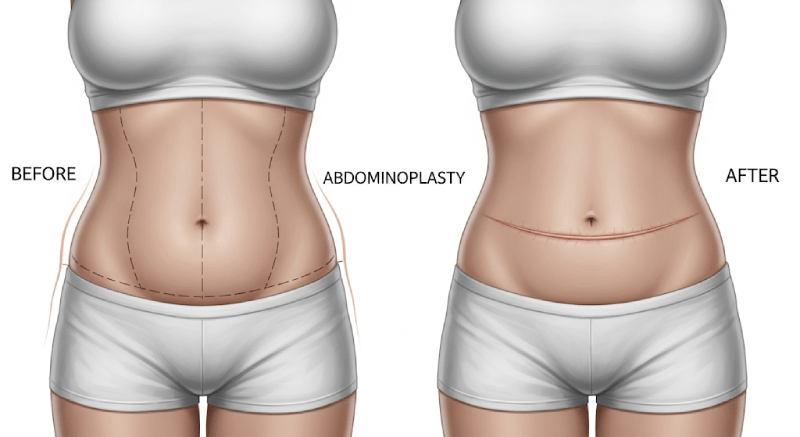
Mini Tummy Tuck (Mini Abdominoplasty)
A mini tummy tuck is a less invasive surgical method that targets excess skin and fat, which is usually gathered below the navel. This operation is ideal for individuals who have had a light weight loss or post-pregnancy, but do not have serious muscle laxity in the abdomen. The surgery is performed with a shorter incision compared to a full tummy tuck, and the position of the navel is not changed. This makes the recovery process shorter and the scar smaller. A mini tummy tuck may not include muscle tightening or may involve only limited tightening for the lower abdominal muscles. Therefore, the patient’s expectations and anatomical structure play a key role in determining the suitability of this operation. Surgeons in Turkey will provide you with the most suitable option after a detailed evaluation.
Full Tummy Tuck (Full Abdominoplasty)
A full tummy tuck is the most effective solution for patients with both lower and upper abdominal muscle laxity, excessive skin sagging, and fat accumulation in the abdominal area. This operation requires two separate incisions: one around the navel and one just above the bikini line. The surgeon tightens the abdominal muscles, removes excess skin and fat tissue, and gives the abdominal area a smoother contour. The navel is repositioned to conform to the new abdominal shape. This procedure not only aesthetically improves the abdominal area but can also contribute to better posture by strengthening the weakened muscles. A full tummy tuck is a more comprehensive operation than other tummy tuck types, and the recovery period may be slightly longer.
Combined Application with Liposuction
Tummy tuck surgery is often combined with liposuction (fat removal). This combination provides excellent results, especially for patients who have both excess skin and stubborn fat deposits in the abdominal area. Liposuction allows the tummy tuck to target not only loose skin and muscles but also localized fat deposits in the abdomen, waist, and flanks. This can result in a more defined and contoured waistline. However, performing these two operations together can extend the duration of the surgery and, therefore, the anesthesia time. The decision to plan the surgery in this way depends on the patient’s overall health and the surgeon’s experience. Many plastic surgery clinics in Turkey successfully perform these combined operations based on the patient’s needs.
Duration of the Surgery
The duration of tummy tuck surgery varies depending on the scope of the operation and the patient’s condition. Generally, a mini tummy tuck takes 1-2 hours, while a full tummy tuck can take between 2-4 hours. If the operation is combined with liposuction, the surgery time may be even longer. The duration of the surgery also depends on the surgeon’s experience, the techniques used, and the patient’s anatomical structure. The longer the surgery, the more the risks associated with anesthesia and surgery can increase, so it is important to discuss this matter in detail with your surgeon.
Post-operative Recovery Period
The post-operative recovery period for tummy tuck surgery varies from patient to patient but generally covers a period of several weeks. The first few days after the surgery are the most critical period.
- First 24-48 Hours: During this period, patients may feel mild to moderate pain and discomfort, which can usually be controlled with painkillers.
- First Week: Walks are important to increase blood circulation and prevent clot formation, but it may be difficult to stand up straight. Wearing a compression garment usually begins.
- First Month: Swelling and bruising begin to decrease. Most patients can return to work but should avoid heavy lifting or strenuous activities.
- First 3-6 Months: Swelling completely disappears, and the scar becomes less noticeable. Most physical activities can be resumed.
Post-operative Pain Management
Post-operative pain can usually be effectively controlled with medication. Your surgeon will prescribe medication for you to use during the post-operative period. Regular and correct use of painkillers makes the recovery process more comfortable. In addition to painkillers, resting, lying in a proper position (usually on your back with bent knees), and light walks can help reduce pain and swelling. Following your surgeon’s recommendations is the most important factor in pain management.
Stitch and Scar Care
Tummy tuck surgery inevitably leaves a scar. Surgeons usually try to hide this scar within the underwear or bikini line. The following steps are important for the best possible scar healing:
- Stitch Care: Keep the suture area clean and dry according to your surgeon’s instructions.
- Massage and Creams: Using special scar creams recommended by your surgeon can help the scar to look better. Scar massage can contribute to the softening of the scar and make it less noticeable.
- Sun Protection: Protecting the scar from direct sunlight is very important during the first year after surgery. Sun exposure can cause the scar to become permanently dark.
When Can One Return to Normal Life?
The time it takes to return to normal life after tummy tuck surgery depends on the patient’s age, overall health, and the scope of the operation.
- Daily Activities: A few days after the surgery, most patients can start doing light walks.
- Return to Work: Those with desk jobs can usually return to work within 2-3 weeks. Those with more physically demanding jobs may need to wait 4-6 weeks.
- Driving: It is generally recommended to wait 2-3 weeks to ensure you are not under the influence of painkillers and can drive safely.
Return to Sports and Exercise
Returning to sports and exercise after surgery is a gradual process, and you should not start strenuous activities without your surgeon’s approval.
- Light Walks: Starting light walks from the first week after surgery is very important to increase blood circulation.
- Gradual Increase: After 3-4 weeks, longer walks or light-paced cardio exercises can be performed.
- Heavy Exercises: It is necessary to wait at least 6-8 weeks for heavy exercises such as weight lifting that strain the abdominal muscles. This period is critical for the complete healing of the abdominal muscles.
- Bodybuilding: It may be necessary to wait 3-6 months before starting intense exercises like bodybuilding.
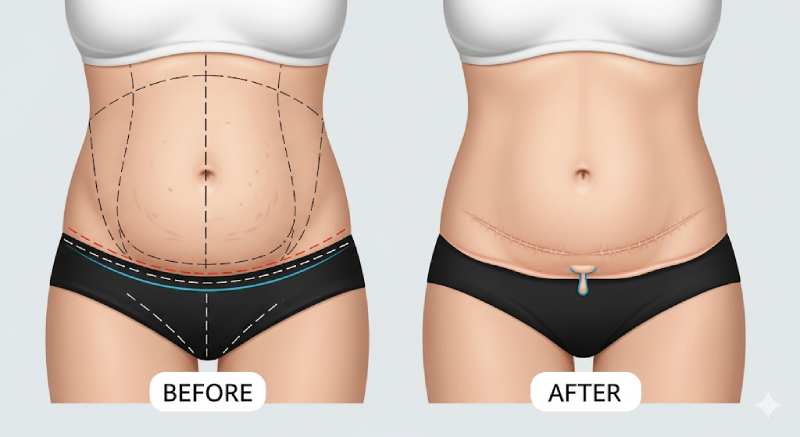
Post-operative Nutrition and Lifestyle
Post-operative nutrition and lifestyle changes are of great importance for a successful recovery and lasting results.
- Healthy Eating: A diet rich in protein, vitamins, and minerals should be adopted to support the body’s healing process.
- Hydration: Drinking enough water helps to eliminate swelling in the body.
- Weight Control: Maintaining the ideal weight is essential to preserve the permanent results of the surgery. This is possible with a healthy diet and regular exercise.
- Smoking and Alcohol: Avoiding smoking and alcohol during the post-operative recovery period reduces the risk of complications and ensures a faster recovery.
What Are the Potential Risks and Complications?
As with any surgical procedure, tummy tuck surgery also has potential risks and complications. These risks can be minimized by following your surgeon’s advice during the pre-operative and post-operative periods.
- Infection: There is a risk of infection in the wound area after surgery.
- Bleeding and Hematoma (Blood Clot): Blood accumulation can occur after surgery, which may require an additional surgical procedure.
- Seroma (Fluid Accumulation): Fluid accumulation under the skin is one of the most common complications and is usually treated with drainage.
- Tissue Loss: Although rare, there is a risk of part of the skin tissue dying (necrosis) due to impaired blood circulation.
- Scar Complications: The scar may thicken in some patients (keloid or hypertrophic scar).
- Asymmetry: A slight asymmetry may occur in the abdominal area after the surgery.
Benefits of Tummy Tuck Surgery
Tummy tuck surgery provides many physical and psychological benefits.
- A Flatter and Firmer Abdomen: The most significant benefit of the surgery is the achievement of a more aesthetic appearance of the sagging and loose abdominal area.
- Improved Body Contour: Tummy tuck creates a more defined body line, especially by slimming the waist area.
- Improved Posture: Tightening the abdominal muscles provides better support for the spine and improves posture.
- Comfort in Wearing Clothes: After the surgery, patients can wear clothes they previously had difficulty with more comfortably.
- Increased Self-Confidence: The positive change in body image significantly increases patients’ self-confidence and quality of life.
- Resolution of Skin Irritation: Skin irritation and hygiene problems caused by sagging skin are eliminated.
Cost and Prices of the Surgery
The cost of tummy tuck surgery varies depending on many factors. These factors include the surgeon’s experience, the location and quality of the hospital or clinic where the surgery will be performed, the type of anesthesia used, and the scope of the operation (mini, full, or combined with liposuction). Turkey is one of the leading countries in aesthetic surgery tourism due to its high-quality healthcare services and competitive prices. If you are planning an operation in Turkey, it is important to first get price quotes from different clinics and surgeons and to ask in detail what services these prices include (hospital stay, anesthesia, medications, compression garment, etc.).
When Are the Results Fully Visible?
The final results of tummy tuck surgery cannot be seen immediately, as it takes time for the post-operative swelling and bruising to completely subside.
- First Few Weeks: Swelling and bruising may be prominent, and the abdomen may not yet look completely flat.
- First 3 Months: Most of the swelling goes down, and the abdomen becomes more shaped. The results begin to be more apparent during this period.
- 6 Months – 1 Year: The final results of the surgery appear during this period. The swelling is completely gone, and the scars become less noticeable.
Permanence and Maintenance of the Results
The results of tummy tuck surgery are permanent as long as a correct lifestyle is adopted. Maintaining the ideal weight and exercising regularly after the surgery ensures that the muscles and skin in the abdominal area stay in shape. If the patient regains weight or becomes pregnant after the surgery, the results of the operation may be compromised. Therefore, adopting a healthy and balanced lifestyle after the surgery is the most effective way to preserve the aesthetic appearance gained.
Revision Surgeries
Although tummy tuck surgeries are generally successful, in some cases, patients may not be completely satisfied with the results or may need an additional operation for various reasons. These are called revision surgeries. Revision surgeries are usually performed for minor corrections (e.g., correcting a scar) or in cases where the results of the first operation were insufficient (e.g., an abdomen that is not tight enough). Plastic surgeons in Turkey have the experience to perform such revision operations.
Choosing an Expert and Clinics in Turkey
Turkey has a worldwide reputation in the field of aesthetic surgery. If you are considering a tummy tuck surgery in Turkey, choosing the right surgeon and clinic is vital for the success and safety of the operation.
- Certified and Experienced Surgeon: Make sure the surgeon you choose is certified by an authorized institution such as the Turkish Plastic, Reconstructive and Aesthetic Surgery Association. Also, review the surgeon’s experience in this field and the results of their previous patients.
- Fully-Equipped Clinic or Hospital: Having the surgery performed in a sterile and fully-equipped hospital with modern equipment minimizes possible risks.
- Consultation: Have a detailed consultation, either in person or online, with your surgeon before the surgery. This will allow you to evaluate how much confidence the surgeon gives you and how well they understand your expectations.
- Post-operative Follow-up: Get information about the clinic’s post-operative follow-up and care services.
Frequently Asked Questions About Tummy Tuck Surgery (FAQ)
Is Tummy Tuck Surgery a Method for Weight Loss?
No, this is not a weight-loss surgery. The best results are achieved in people who are close to their ideal weight and only have excess skin and muscle laxity.
Will There Be a Scar After the Surgery?
Yes, a horizontal scar will remain above the bikini line after the surgery. This scar fades over time and becomes less noticeable, and can be easily hidden with underwear.
How Long Does the Recovery Period Take?
Most patients can return to work within 2-3 weeks, but it may take 6 months to 1 year for full recovery and final results.
Can One Become Pregnant Again After the Surgery?
Yes, but this can cause the abdominal muscles to stretch again and ruin the results of the surgery. Therefore, it is recommended that people who plan future pregnancies postpone the surgery.
How Safe is Tummy Tuck Surgery?
When performed by an experienced surgeon in a fully-equipped hospital, it is a safe operation. However, like any surgical procedure, there are potential risks, and these risks should be discussed in detail with your surgeon.
